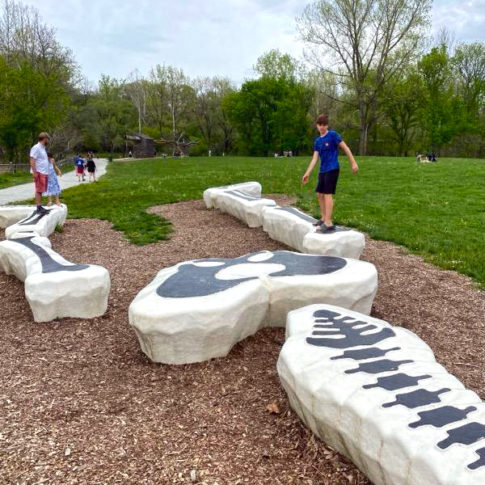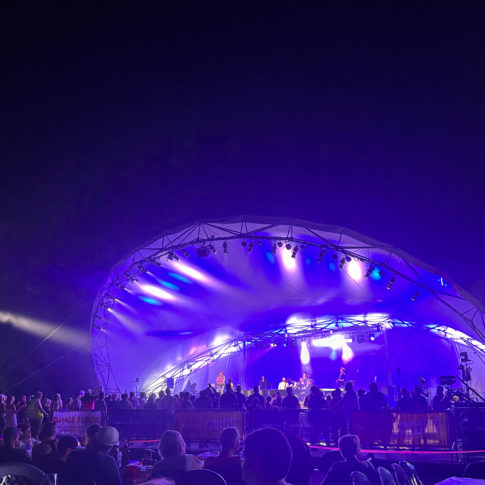The White River offers a range of volunteer opportunities for individuals passionate about public lands, community engagement, arts and culture, and environmental stewardship.
Wildlife Viewing
Birds, bees and tulip trees.
Viewing the wildlife in their natural habitat is one of the best ways to enjoy the White River. Whether watching an eagle fly overhead or fish swim below, this quiet activity allows for a great connection to nature. Below are a few helpful tips to get the most out of the experience without disturbing the natural environment.
Here are some tips for seeing wildlife near the White River in Central Indiana:
Be quiet: One of the best ways to increase your chances of seeing wildlife is to move quietly and avoid making loud noises. Use a paddle with a soft grip, and try to move slowly and smoothly through the water.
Observe from a distance: Wildlife can be easily spooked by humans, so it’s important to observe from a respectful distance. Use binoculars or a zoom lens to get a closer look without disturbing the animals.
Look for signs of wildlife: Even if you don’t see the animals themselves, you may be able to spot signs of their presence, such as tracks, scat or scratch marks on trees.
Know the best times of day: Many animals are most active at dawn and dusk, so these are good times to be on the lookout. Additionally, during the hot summer months, animals may be more active in the early morning or late evening to avoid the heat of the day.
Stay alert: Wildlife can appear suddenly and unexpectedly, so it’s important to stay alert and keep your eyes and ears open. Scan the shoreline and tree branches for movement or unusual shapes, and listen for sounds such as rustling leaves or bird calls.
Respect wildlife and their habitats: Remember that you are a visitor in the animals’ home, so it’s important to treat them and their habitats with respect. Avoid approaching or disturbing animals, and be sure to properly dispose of any trash or litter.
Birds
While paddling or hiking along the White River in Central Indiana, you may have the opportunity to see a variety of birds that are common to the area. Here are some of the birds you might spot:
Great Blue Heron: This tall, blue-gray bird is a common sight along the White River. They can often be seen wading in shallow water and hunting for fish.
Bald Eagle: Bald Eagles are found year-round in the area and can be seen flying over the river, perched in trees or fishing in the water.
Wood Duck: These colorful ducks are often seen swimming in pairs or small groups along the river.
Belted Kingfisher: These noisy birds are easily recognized by their distinctive call and their habit of hovering over the water before diving in to catch fish.
Canada Goose: These large, honking birds are a common sight along the White River, particularly in the fall and winter months.
Osprey: These fish-eating birds are sometimes seen along the White River, particularly near dams or other areas where fish are concentrated.
Red-tailed Hawk: Red-tailed Hawks are commonly seen in the area and can be identified by their broad wings and reddish-brown tails. They can often be seen perched in trees along the riverbank.
Cooper’s Hawk: Cooper’s Hawks are smaller than Red-tailed Hawks and have a distinctive shape and long tail. They are often seen darting through the trees in pursuit of prey.
Northern Harrier: Northern Harriers have a distinctive white rump and can often be seen gliding low over the marshy areas along the river.
Sharp-shinned Hawk: Sharp-shinned Hawks are small and agile and can often be seen chasing after smaller birds, such as finches or sparrows.
Broad-winged Hawk: Broad-winged Hawks are known for their high-pitched, piercing call and can often be seen soaring overhead during migration.
Songbirds: The river corridor provides habitat for a wide variety of songbirds, including warblers, finches and sparrows, which can often be seen and heard in the trees along the riverbank.
Remember to keep a respectful distance from any wildlife you may encounter and avoid disturbing their natural behavior. Additionally, it’s important to never disturb nesting birds or their habitats.
In addition to birds that live near the river year-round, the White River in Central Indiana serves as an important stopover and breeding habitat for many migratory birds. Here are some of the migratory birds that use the White River:
Warblers: During the spring and fall migrations, a variety of warbler species can be found in the trees along the riverbank, including Yellow Warblers, Black-and-White Warblers and Prothonotary Warblers.
Sandhill Cranes: In the fall, large flocks of Sandhill Cranes can be seen flying over the White River as they migrate south for the winter.
Waterfowl: During the fall and winter, the White River attracts a variety of waterfowl, including Canada Geese, Mallards and Northern Pintails.
Shorebirds: During the fall migration, a variety of shorebirds can be found along the riverbank, including Greater Yellowlegs, Least Sandpipers and Killdeer.
Mammals
While paddling on the White River in Central Indiana, you may have the opportunity to see a variety of mammals that are common to the area. Here are some of the mammals you might spot:
Beavers: These large rodents are often seen swimming in the river or constructing dams and lodges along the banks.
White-tailed deer: These graceful animals are common in the woods and fields along the river, and may be seen swimming across the river at times.
Raccoons: These nocturnal animals are often seen along the riverbank or swimming in the water, and may come out at dusk or nightfall to forage for food.
Muskrats: These semi-aquatic rodents are often seen swimming in the river or building dens along the banks.
River Otters: These playful animals are becoming more common in the area and can be seen swimming in the river, playing on logs or hunting for fish.
Coyotes: These canines are becoming more common in the area and may be seen along the riverbank or crossing the river at times.
Squirrels: Various species of squirrels can be seen in the trees along the riverbank, such as Eastern Gray Squirrel, Fox Squirrel and Red Squirrel.
Remember to keep a respectful distance from any wildlife you may encounter and avoid disturbing their natural behavior. Additionally, it’s important to never feed wildlife and to properly store food and trash to avoid attracting animals to your campsite or paddling area.
Pollinators
Several large pollinator garden restorations can be found along the White River. The Monarch Butterfly Sanctuary in Indy is along the Urban Wilderness Trail in the floodplain near White River State Park. First planted in 2017 with more than 2,600 pollinator-friendly native plants and shrubs, the garden now hosts an annual Monarch tagging event to monitor the health of the species.
The Wild Birds Unlimited Native Pollinator Meadow, located in Fairbanks Park at Newfields, is the largest pollinator meadow in the city. The 1.5 acre meadow is part of a long-term restoration strategy that has included removing more than 40 acres of invasive honeysuckle and planting of more than 70,000 native plants throughout the park.
At Conner Prairie, more than half of William Conner’s original farm has been restored with removal of invasive species and planting of native prairie plants. Much of this work is shared during the warmer months of the year through Conner Prairie’s Habitat exhibition and is visible from the main Conner home.
At Strawtown Koteewi Park, a large native prairie and wetland restoration program covers much of the more than 800 acre park. Nature trails and boardwalks allow you to walk along the edge of these habitats.
The White River in Central Indiana provides habitat for a wide variety of pollinators. Here are some of the pollinators you might see along the river:
Bees: Many species of bees can be found along the White River, including honey bees, bumblebees and solitary bees. They are important pollinators for a variety of plants, including wildflowers, fruit trees and crops.
Butterflies: The White River is home to several species of butterflies, including Monarchs, Swallowtails and Fritillaries. They play an important role in pollinating flowers and other plants along the riverbank.
Moths: Like butterflies, moths are important pollinators along the White River. Some species, such as the Sphinx Moth, are known for their long tongues that allow them to reach the nectar in deep flowers.
Beetles: Although less well-known as pollinators, some species of beetles also play an important role in pollination along the White River. They are attracted to flowers with strong scents and can carry pollen from flower to flower.

Learn More
Since the retreat of the glaciers 10,000 years ago, the meandering flow of the White River has been carving the landscape of Central Indiana. The river’s timeless beauty is still […]
Get ready to experience the best of the White River this summer! The colors of spring give way to the sounds of summer as the river corridor comes alive with […]


